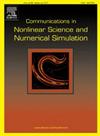非线性反应扩散方程的 BDF2 完全离散方案的超收敛分析和外推法
IF 3.4
2区 数学
Q1 MATHEMATICS, APPLIED
Communications in Nonlinear Science and Numerical Simulation
Pub Date : 2024-11-16
DOI:10.1016/j.cnsns.2024.108446
引用次数: 0
摘要
本文的主要目的是针对非线性反应扩散方程,提出一种双线性 Q11 有限元法(FEM)的两步后向微分公式(BDF2)全离散方案。通过使用元素插值和 Ritz 投影的组合技术,并通过插值后处理方法,严格推导出了 H1 规范下阶数为 O(h2+τ2)的超近和全局超收敛估计。此外,借助 Q11 元素的渐近误差扩展,开发了一种新的合适的全离散方案,并推导出了 H1 规范下 O(h3+τ2)阶的外推结果,比上述传统超收敛估计值的 h 值高一个阶。最后,我们提供了一些数值结果来验证理论分析。完全离散有限元方案的外推似乎在以往的研究中从未出现过。本文章由计算机程序翻译,如有差异,请以英文原文为准。
Superconvergence analysis and extrapolation of a BDF2 fully discrete scheme for nonlinear reaction–diffusion equations
The main aim of this paper is to propose a 2-step backward differential formula (BDF2) fully discrete scheme with the bilinear finite element method (FEM) for the nonlinear reaction–diffusion equation. By use of the combination technique of the element’s interpolation and Ritz projection, and through the interpolation post-processing approach, the superclose and global superconvergence estimates with order in -norm are deduced rigorously. Furthermore, with the help of the asymptotic error expansion of the element, a new suitable fully discrete scheme is developed, and the extrapolation result of order in -norm is derived, which is one order higher than that of the above traditional superconvergence estimate with respect to . Here is the mesh size and is the time step. Finally, some numerical results are provided to verify the theoretical analysis. It seems that the extrapolation of the fully discrete finite element scheme has never been seen in the previous studies.
求助全文
通过发布文献求助,成功后即可免费获取论文全文。
去求助
来源期刊

Communications in Nonlinear Science and Numerical Simulation
MATHEMATICS, APPLIED-MATHEMATICS, INTERDISCIPLINARY APPLICATIONS
CiteScore
6.80
自引率
7.70%
发文量
378
审稿时长
78 days
期刊介绍:
The journal publishes original research findings on experimental observation, mathematical modeling, theoretical analysis and numerical simulation, for more accurate description, better prediction or novel application, of nonlinear phenomena in science and engineering. It offers a venue for researchers to make rapid exchange of ideas and techniques in nonlinear science and complexity.
The submission of manuscripts with cross-disciplinary approaches in nonlinear science and complexity is particularly encouraged.
Topics of interest:
Nonlinear differential or delay equations, Lie group analysis and asymptotic methods, Discontinuous systems, Fractals, Fractional calculus and dynamics, Nonlinear effects in quantum mechanics, Nonlinear stochastic processes, Experimental nonlinear science, Time-series and signal analysis, Computational methods and simulations in nonlinear science and engineering, Control of dynamical systems, Synchronization, Lyapunov analysis, High-dimensional chaos and turbulence, Chaos in Hamiltonian systems, Integrable systems and solitons, Collective behavior in many-body systems, Biological physics and networks, Nonlinear mechanical systems, Complex systems and complexity.
No length limitation for contributions is set, but only concisely written manuscripts are published. Brief papers are published on the basis of Rapid Communications. Discussions of previously published papers are welcome.
 求助内容:
求助内容: 应助结果提醒方式:
应助结果提醒方式:


